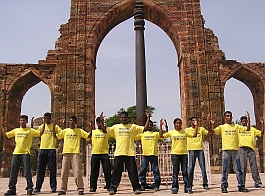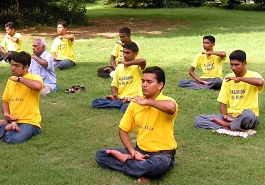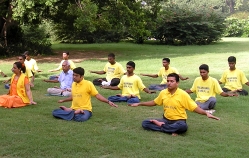Introduction to Falun Dafa
What is Falun Dafa?
Falun Dafa (also called Falun Gong, or just Dafa) is a high-level cultivation practice guided by the characteristics of the universe—Truthfulness, Benevolence, and Forbearance.
"Cultivation" means continuously striving to better harmonize oneself with these universal principles. “Practice” refers to the exercises – five sets of easy-to-learn gentle movements and meditation. Cultivating oneself is essential; practicing the exercises supplements the process.
Over time, the principles of Dafa unveil the deepest and most profound truths of the universe. Following the principles, practitioners of Falun Dafa are able to reach very high realms, enlightening to the true meanings of life, and finding the path of return to their origins and true selves.
While the exercises have deep inner meanings, they also help to reduce stress and can bring great improvements in health and fitness.

About 30,000 attend a group exercise practice in a stadium in Harbin City, Heilongjiang Province. Such gatherings were common in China before the persecution began in 1999
The Beginnings
Falun Dafa has an ancient history. It was passed down over the ages from a single master to a single disciple in each generation. The disciple would later have a disciple of his own, to whom he would pass on the teachings, thereby quietly passing the practice down throughout history.
In 1992, Mr. Li Hongzhi (referred to respectfully by practitioners as "Master" or "Teacher") first taught Falun Dafa publicly in the city of Changchun, China, and then continued to lecture all across the country. Those who attended experienced such profound benefits that they told friends and family. As a result, the number of practitioners grew very quickly, solely by word of mouth. By 1998, at least 70 million people had taken up the practice in China alone.
Today, Dafa is practiced and cherished by over 100 million people in over 100 countries, and has received a plethora of honors.

Practitioners do the second exercise in Delhi
More About the Practice
Cultivators of Falun Dafa strive to cultivate their xinxing [mind-nature, or character] and remove their attachments to become kinder, more honest and more patient people. The higher one is able to elevate xinxing, the deeper the understanding one has of the teachings presented in Zhuan Falun (Falun Dafa’s primary text).
Falun Dafa practitioners cultivate themselves while living normally in the complex environment of secular society. People of all nationalities, races, socio-economic backgrounds, gender, ages, occupations, and different faiths are welcome to practice, and do so entirely of their own free will, at their own pace, and for as long as they choose.

The Falun
A prominent feature of Falun Dafa is the Falun or Law Wheel. The Falun emblem is comprised of various forms of yin-yang symbols (also known as Taichi symbols) and swastikas (known as wan in Chinese). Yin-yang symbols are traditionally associated with Taoist schools of thought, while swastikas have been associated for millennia with ways of cultivation in the Buddha school. To learn more about the Falun, click here. More about the swastika here.

Practitioners doing the 5th Exercise in a Park in Delhi
How to Learn
Local assistants and veteran practitioners teach the exercises, always free of charge, at practice sites in cities and towns around the world. All books, lectures and a complete library of audio and visual materials to help you learn the practice are available for free download on this website.
For more on how to learn, including links to all materials recommended for beginners, visit our How to Learn page.

Practitioners meditate in a scenic spot in Delhi
Frequently Asked Questions
- What's the difference between Falun Gong and Falun Dafa?
- Who practices Falun Dafa?
- Do you have to do it outdoors?
- Do I have to know Chinese?
- How much does it cost?
- How long does it take to learn?
- How long does it take to practice the exercises each day?
- Will this interfere with the practice of my religious beliefs?
- Can young children practice it?
- Why does the Falun Dafa symbol look like a swastika?
- Who is Mr. Li Hongzhi?
- Why is Mr. Li Hongzhi referred to as "Master"?
- Why is Falun Dafa persecuted in China?